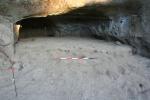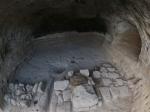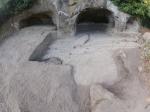Summary (English)
This was the 45th consecutive excavation campaign at the Final Bronze Age settlement of Sorgenti della Nove (Farnese, VT). This year, the excavations were concentrated in sector XIII, where investigations began in 2015.
This sector is constituted by a narrow section of sloping rock, identified as a road, onto which face three artificial grottoes (nos. 51, 52, 53). The excavations began in the easternmost one, Grotto 51, and its investigation was concluded this year.The cavity is formed of a single chamber inside which the modern occupation levels and the abandonment layer obliterated two medieval occupation layers, the earliest of which represented by a wall built of tufa blocks bonded with mortar that closed the space. The removal of these layers revealed a floor surface on which structures attributable to the proto-historic period were present, which may have been part of a system for collecting water and draining it towards the exterior.
The area in front of the grotto was not a terrace, as supposed at the beginning of the investigations, but a sloping road, in which three small channels and numerous postholes had been cut during the proto-historic period. Others could not be dated but the materials present in the fills dates their disuse to the medieval period.
There was evidence of a collapsed vault in the south-eastern corner of the sector. Therefore, it seems plausible to suggest the existence of another series of structures that probably faced on to a lower terrace.A second intervention took place in the westward extension of the sector, beginning the investigation of Grotto 52. This decision was based on the continuation of the stratigraphy in section and the presence of the new grotto in the south corner of the area. In fact, Grotto 52 and the area in front of it were occupied by a substantial stratigraphy, which needed to be removed in order to excavate the underlying grotto in the future.
This new area presented a situation that had already been seen, with a modern beaten earth floor surface inside the grotto and to the exterior, which obliterated the abandonment layer formed by a natural collapse situated in front of the grotto and in correspondence with the entrance.
Inside the cave, the removal of the abandonment levels revealed a beaten earth floor surface, not yet removed, probably relating to a medieval phase.It will only be possible to understand this stratigraphy with the continuation of the investigations, which should also clarify the layout of this grotto complex, the road in front of it and the different occupation phases.
- Nuccia Negroni Catacchio - già Università degli studi di Milano, Politecnico di Milano, Centro Studi di Preistoria e Archeologia, Milano
- Denise Felline - Centro Studi di Preistoria e Archeologia, Milano
- Veronica Gallo - Centro Studi di Preistoria e Archeologia, Milano e Università degli Studi di Padova
Director
- Nuccia Negroni Catacchio - già Università degli studi di Milano, Politecnico di Milano, Centro Studi di Preistoria e Archeologia, Milano
Team
- Denise Felline - Centro Studi di Preistoria e Archeologia, Milano
- Veronica Gallo - Centro Studi di Preistoria e Archeologia, Milano e Università degli Studi di Padova






![Download [PDF]](/excavation/skins/fasti/images/results/download_sml.png)

